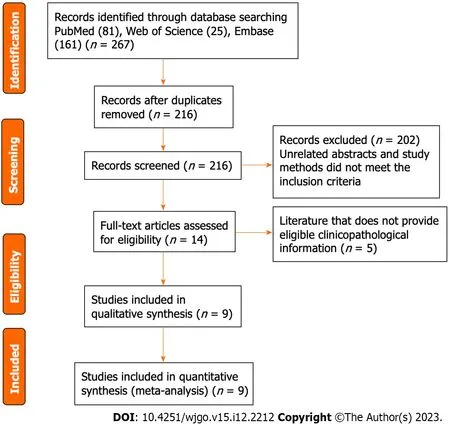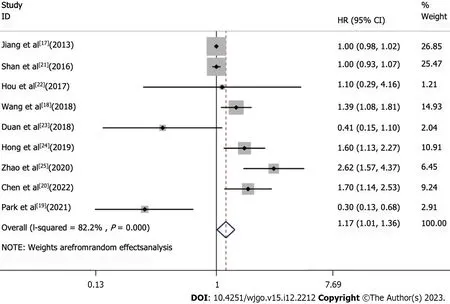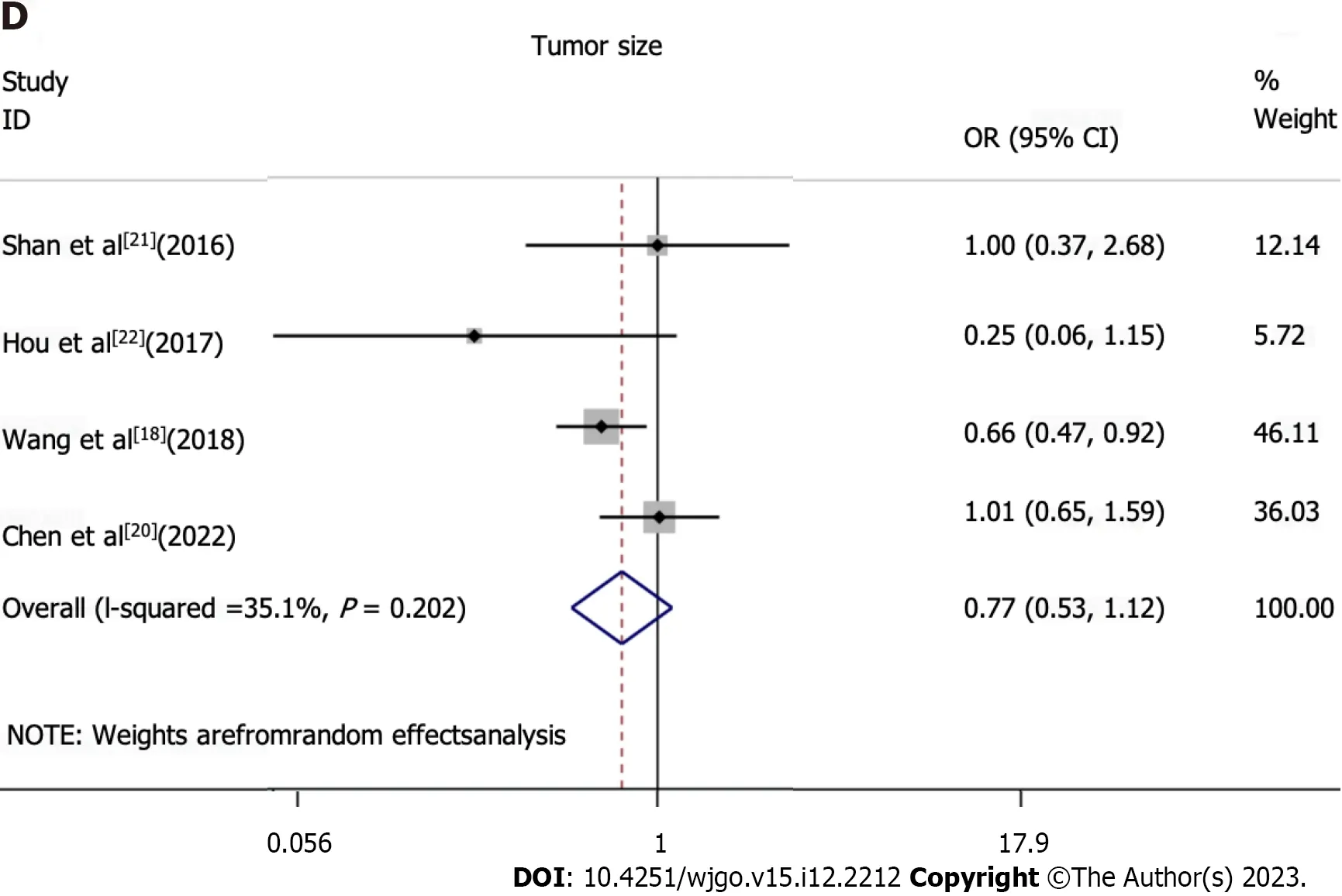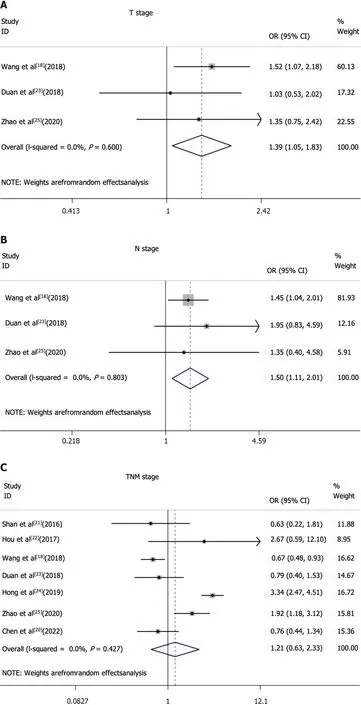Prognostic value of T cell immunoglobulin and mucin-domain containing-3 expression in upper gastrointestinal tract tumors: A meta-analysis
Jing-Jing Yan,Bing-Bing Liu,Yan Yang,Meng-Ru Liu,Han Wang,Zhen-Quan Deng,Zhi-Wei Zhang
Abstract BACKGROUND There is a lack of robust prognostic markers for upper gastrointestinal (GI) tract cancers,including esophageal,gastric,and esophagogastric junction cancers.T cell immunoglobulin and mucin-domain containing-3 (TIM3) plays a key immunomodulatory role and is linked to the prognosis of various cancers.However,the significance of TIM3 in upper GI tract tumors is still uncertain.AIM To investigate the prognostic value of TIM3 expression in upper GI tract tumors.METHODS A literature search was conducted on the PubMed,Embase,and Web of Science databases for relevant studies published until June 2023.After screening and quality assessment,studies that met the criteria were included in the metaanalysis.Statistical methods were used for the pooled analysis to assess the association of TIM3 expression in upper GI tract tumors with the prognosis and clinicopathological parameters.The results were reported with the hazard ratio (HR) and 95% confidence interval (CI).RESULTS Nine studies involving 2556 patients with upper GI tract cancer were included.High TIM3 expression was associated with a worse prognosis in upper GI tract cancer (HR: 1.17,95%CI: 1.01-1.36).Positive expression of TIM3 in gastric cancer was correlated with the T and N stage,but the difference was not statistically significant.However,TIM3 overexpression was significantly correlated with the TNM stage (odds ratio: 1.21,95%CI: 0.63-2.33;P <0.05).TIM3 expression showed no association with the other clinicopathological parameters.CONCLUSION High expression of TIM3 in the upper GI tract cancer is associated with a worse prognosis and advanced T or N stages,indicating its potential value as a prognostic biomarker.These findings may provide a basis for the personalized treatment of upper GI tract cancers.
Key Words: Immune checkpoint;T cell immunoglobulin-3;Upper gastrointestinal tract cancer;Overall survival;Clinicopathological features
INTRODUCTION
The high incidence of cancer is a major public health concern worldwide[1].An analysis of cancer statistics in 2022 revealed a declining trend in the incidence and mortality rates of malignant tumors in the United States[2].However,upper gastrointestinal (GI) tract tumors,including esophageal cancer,gastric cancer,and esophagogastric junction cancer,continue to pose a serious threat to health.Gastric cancer is the fifth most common cancer worldwide,and the fourth highest contributor to cancer-associated mortality.Worldwide,esophageal cancer ranks seventh in terms of incidence and sixth in terms of mortality[3].
Recent data have suggested a gradual decrease in the incidence of gastric cancer in China.However,it remains the fourth most commonly occurring cancer and the third most common cause of cancer-associated mortality in China,whereas esophageal cancer is among the top five causes of cancer-related deaths[4].
A diverse range of treatment methods are presently available for upper GI tract tumors.In addition to traditional treatments (surgery,chemotherapy,and radiotherapy),targeted therapy,immunotherapy,and combination therapy have exhibited promising results in certain subsets of patients.However,despite these novel therapeutic approaches,the prognosis of patients with middle-and advanced-stage upper GI tract tumors remains unsatisfactory.In recent years,immunotherapy using immune checkpoint inhibitors has transformed the treatment landscape for various types of cancers.Combination therapy containing immunotherapy has been the first-line treatment for advanced upper GI tract tumors.Approximately 15%-20% of patients with gastric adenocarcinoma overexpress human epidermal growth factor receptor 2 (HER2).While trastuzumab was once favored for treating HER2-positive advanced gastric cancer,the DESTINY-Gastric01 study highlighted trastuzumab deruxtecan as a superior option[5].The MOUSEION series indicates that immunotherapy benefits both men and women,but women may show a reduced response to monotherapy[6].Moreover,combining two immune checkpoint inhibitors yields better outcomes,and while not all gastric cancer patients show a positive response,those with high microsatellite instability or Epstein-Barr virus positivity exhibit a strong response to pembrolizumab[7].The synergy of chemotherapy and immunotherapy,especially targeting the DNA damage response pathway,offers promising prospects in gastric cancer treatment[8].Furthermore,immune checkpoints represent a contemporary research hotspot among prognostic markers.
Immune checkpoints are inhibitory molecules that can modulate the immune system to reduce unwanted autoimmune responses,thereby helping maintain self-tolerance and regulating the timing of physiological immune responses in peripheral tissues[9].In the cancer microenvironment,T lymphocytes play a central role in cell-mediated cytotoxicity.Activated T cells express inhibitory receptors,such as cytotoxic T-lymphocyte-associated protein 4 (CTLA-4) and programmed cell death protein 1 (PD-1).Cancer cells express ligands,such as programmed death-ligand 1 (PD-L1),which can combine with PD-1 and further weaken the antitumor effects of T cells[10,11].The blockade of immune checkpoints can have powerful and durable antitumor effects.
In March 2011,the United States Food and Drug Administration approved ipilimumab,a monoclonal CTLA-4 antibody,for the treatment of patients with late-stage melanoma[12].PD-1/PD-L1 blockers are among the most successful checkpoint inhibitors[13].PD-1 or PD-L1 inhibitors have been approved as first-or second-line treatment for several cancers,such as non-small cell lung cancer,melanoma,and gastric cancer[14].Therefore,immune checkpoint inhibitors are presently an important component of comprehensive cancer therapy.
At present,the most commonly used immune checkpoint molecular targets are PD-1,CTLA-4,lymphocyte activation gene-3 (LAG-3),and T cell immunoglobulin-3 (TIM3).Among these,TIM3,also referred to as hepatitis A virus-cell receptor 2,is a transmembrane protein that negatively regulates type 1 immunity and plays an important regulatory role in carcinogenesis and development[15].This suppresses the activity of T cells and other immune cells by binding to its ligand galectin-9 (Gal-9),thereby regulating the intensity and duration of the immune response[16].
Recent studies have demonstrated high TIM3 expression in upper GI tract tumor tissues,and its close association with overall survival (OS).For example,studies have reported a correlation between TIM3 expression level and the prognosis of gastric[17-20] and esophageal[21-25] cancers.However,the prognostic value of TIM3 in gastroesophageal junction cancer has not been reported.The results suggest the important role of TIM3 in these tumors.
Therefore,a meta-analysis was conducted to comprehensively assess the relationship between TIM3 expression level and the prognosis and clinicopathological parameters of upper GI tract tumors.
MATERIALS AND METHODS
Search strategy and study selection
A literature search was performed in the PubMed,Web of Science,and Embase databases for studies published as of June 30,2023.The keywords used were “TIM3,” “gastric cancer,” and “esophageal cancer.” No studies have investigated TIM3 expression in gastroesophageal junction cancer.In addition,to prevent the omission of relevant literature,especially focused literature,we used a new tool,Reference Citation Analysis (https://www.referencecitationanalysis.com),to analyze the articles.Next,a systematic approach was used to select eligible studies and extract relevant data.The reference lists of the selected articles were screened to identify additional studies that met the criteria for inclusion in the present meta-analysis.Only publicly available published data were used for the present study,precluding any concerns related to personal privacy or ethical issues.The present meta-analysis is registered on the PROSPERO website (https://www.crd.york.ac.uk/PROSPERO/;Registration No.CRD42023438756).
Study selection criteria
Studies that met the following criteria were eligible for inclusion: (1) Case-control studies,cohort studies,or clinical trials;(2) patients with upper GI cancer;(3) diagnosis confirmed by histopathology;(4) detection of TIM3 expression by immunohistochemistry (IHC);and (5) variables reported of TIM3 expression levels and cancer prognosis-related outcomes (such as OS).
The exclusion criteria were: (1)In vitrostudies or animal experiments;(2) inability to extract the required data from the published results;(3) non-reporting of survival outcomes;and (4) patients who received chemotherapy or radiotherapy before the assessment of TIM3 expression.
Data extraction and quality assessment
Two researchers independently extracted the data pertaining to the following variables from each study: Study design,sample size,demographic characteristics (including age,sex,nationality,and ethnicity),clinicopathological parameters (T stage,lymph node metastasis,tumor-node-metastasis [TNM] stage,and grade of differentiation),and prognostic indices (such as OS).The specifics of the TNM staging were meticulously documented.The methods and thresholds for determining TIM3 expression,primarily through IHC,were outlined.Using the Newcastle-Ottawa Scale (NOS) for quality assessment,only studies that scored between 6 to 9 points,denoting high quality,were included in the metaanalysis.
Statistical analyses
Pooled analyses of data obtained from the included studies were performed using STATA statistical software,version 15.2.P<0.05 was considered statistically significant for all analyses.The pooled hazard ratios (HRs) and 95% confidence interval (CIs) were calculated to assess the association between TIM3 expression and the prognosis and clinicopathological parameters (sex,age,T stage,lymph node metastasis,TNM stage,and grade of differentiation) of GI tract cancer.The individual HR estimates were pooled into a summary HR.The assumption of homogeneity was tested by performing Cochran’s Q-statistic andI2test for heterogeneity.P<0.05 in the Q-test orI2>50% was considered indicative of significant heterogeneity.In case of significant heterogeneity,the random-effects model was used for the meta-analysis;otherwise,the fixed-effects model was used.HR or odds ratio (OR) >1 (indicating worse prognosis for cases with TIM3 expression positivity) was considered statistically significant when the 95%CI did not overlap 1.In case of significant heterogeneity among the included studies,subgroup analysis or sensitivity analysis was performed to identify the source of heterogeneity and explore the impact of potential factors on the results.The results were presented as forest plots.The effect of potential publication bias on the results of the meta-analysis was assessed by drawing funnel plots,and performing the Begg’s rank correlation test.
RESULTS
Selection of trials
The flow diagram illustrating the study selection process and criteria is presented in Figure 1.A total of 267 studies that investigated the association of TIM3 expression in upper GI tract cancer with both prognosis and clinicopathological parameters were retrieved during the database search.Among these studies,51 duplicate publications were excluded.Of the remaining 216 articles,202 were excluded after the review of the abstracts and study methods,since these did not meet the inclusion criteria.Subsequently,the full texts of the remaining 14 articles were reviewed.Of these 14 studies,5 that did not provide qualifying clinicopathological information were excluded.Finally,the remaining nine studies,which enrolled 2556 patients,were included in the pooled analysis.These studies were published between 2013 and 2022.In each of the eligible studies,TIM3 expression in upper GI tract cancer was reported to be associated with OS.All studies were considered high quality based on the NOS assessment (average score: 8).Table 1 summarizes the characteristics of the selected studies.

Table 1 Characteristics of studies included for the meta-analysis

Figure 1 Flow diagram for the study selection criteria and process.
Association between TIM3 expression and OS
Nine studies were included in the pooled analysis of the association between TIM3 expression and OS (Figure 2).It was noteworthy that no significant positive results were obtained from the literature data provided by Wanget al[18] and Parket al[19].Nonetheless,these results revealed that high TIM3 expression was associated with a worse prognosis of upper GI tract tumors,with a pooled HR of 1.17 (95%CI: 1.01-1.36).To further investigate the prognostic significance of TIM3 in different types of upper GI tumors,we performed the analyses grouped by cancer type (Supplementary Figures 1 and 2).In addition,there were two papers in which the data were obviously biased.To further illustrate the situation,we showed the result after removing these two papers (Supplementary Figure 3),and found that high TIM3 expression was significantly associated with poorer survival of upper GI cancers.The abovementioned results indicate that high expression of TIM3 may be a predictor of poor prognosis,shorter survival,and a higher risk of recurrence in patients with upper GI cancers.

Figure 2 Meta-analysis of the association between T cell immunoglobulin and mucin-domain containing-3 expression and overall survival. Hazard ratio forest plot for the association between the T cell immunoglobulin and mucin-domain containing-3 expression and overall survival in upper gastrointestinal tract tumors.

Figure 3 Association between T cell immunoglobulin and mucin-domain containing-3 expression and clinicopathological characteristics was analyzed. Forest plots with Odds ratio (OR) and 95% confidence interval (CI) were drawn for the association of T cell immunoglobulin and mucin-domain containing-3 expression with clinicopathological characteristics.A: Sex;B: Age;C: Tumor location;D: Tumor size.

Figure 4 Association between T cell immunoglobulin and mucin-domain containing-3 expression and clinicopathological characteristics was analyzed. Forest plots of odds ratio (OR) and 95% confidence interval (CI) were performed for correlation between T cell immunoglobulin and mucin-domain containing-3 expression and Tumor staging and grade of tissue differentiation.A: T stage;B: N stage;C: TNM stage;D: Grade of tissue differentiation.
Association between TIM3 expression and clinicopathological characteristics
All studies included in the meta-analysis had analyzed data on TIM3 expression,and at least one clinicopathological parameter for upper GI tract tumors (Figures 3 and 4,Table 2).TIM3 expression was associated with the T and N stage,and was significantly correlated with the TNM stage.However,among the other clinicopathological parameters,TIM3 expression was not associated with sex,age,tumor location,size,or grade.

Table 2 Sub-group analysis of the association between T cell immunoglobulin and mucin-domain containing-3 and the clinicopathological parameters
On analysis of the T stage for assessing the degree of primary tumor invasiveness,TIM3 expression was found to be associated with the T stage (T1-2vsT3-4,OR: 1.39,95%CI: 1.06-1.83;fixed effects model).Furthermore,TIM3 expression was higher in the T3-4 group compared to the T1-2 group,although the difference was not statistically significant (P>0.05).This result suggests the potential role of TIM3 expression in the depth of tumor invasion of upper GI tract tumors.The analysis of the distribution of involved lymph nodes (stage N) revealed that TIM3 expression was greater in the N2-3group compared to the N0-1 group (N0-1vsN2-3,OR: 1.5,95%CI: 1.11–2.01;random effects model),although the difference was not statistically significant (P>0.05).Furthermore,the results suggested that TIM3 expression may be correlated with the N stage in upper GI tract tumors.However,further studies are required to explore this association.In further analyses,TIM3 overexpression was found to be correlated with the TNM stage,since TIM3 expression was higher in the III/IV stage of gastric cancer compared to the I/II stage (I/IIvsIII/IV,OR: 1.21,95%CI: 0.63–2.33,random-effects model).Therefore,TIM3 overexpression may play an important role in the development of upper GI tract tumors.
Sensitivity analysis and publication bias assessment
In the sensitivity analysis,the pooled analysis results remained stable and consistent across the different statistical models and methods,reinforcing the reliability of the results.Furthermore,the funnel plot and Begg’s rank correlation test revealed no significant effect of potential publication bias on the results of the meta-analysis (Figure 5).

Figure 5 Assessment of publication bias and sensitivity analysis. A: Funnel plot that assessed the effect of potential publication bias on the metaanalysis results;B: Sensitivity analysis that evaluated the impact of omitting individual studies on the pooled effect size estimate to determine the association between the T cell immunoglobulin and mucin-domain containing-3 expression and prognosis in upper gastrointestinal tumors.HR: Hazard ratio.
DISCUSSION
Upper GI tract tumors are a group of malignant tumors with a high incidence and associated mortality.The pathogenic mechanism of these tumors is complex,and intricately linked to the immune system.The immune system plays a crucial role in the initiation,advancement,and spread of cancer[26,27].As cancer advances,exosomes released by the tumor cellsnot only facilitate tumor immune evasion but also serve as biomarkers of autoimmune response[28].Notably,serum pepsinogen,a biomarker,is widely believed to reflect the pathological changes in the stomach[29].Biomarkers are indispensable in cancer diagnosis and treatment,aiding in early diagnosis,evaluating therapeutic efficacy,predicting disease progression,and offering vital information for personalized treatment.The immunomodulatory molecule TIM3,which is an important immune checkpoint[30,31],plays a key role in tumor immune evasion and treatment resistance,and is expressed in both serum and tumors.Furthermore,TIM3 can suppress tumor immune responses by modulating the function of T helper 1 CD4 T cells and cytotoxic CD8 T cells[32].Studies conducted in the context of melanoma,and head and neck cancers have revealed that TIM3 can limit the antitumor immunity[33,34].TIM3 enhances the growth of hepatocellular carcinoma by inducing the functional blockade of natural killer cells[35].Furthermore,TIM3 has been identified as a marker of microsatellite-stable colorectal carcinoma with immune failure and distinct clinicopathological features[36].Moreover,TIM3,which acts with its ligand CEA cell adhesion molecule 1,can suppress T cells,thereby downregulating antitumor immunity[37,38].Of note,the serum levels of TIM3 and Gal-9 are significantly elevated in patients with systemic mastocytosis,suggesting the potential value of TIM3 in the diagnosis and treatment of this condition[39].However,the prognostic significance of TIM3 in upper GI tract tumors remain inconsistent.Therefore,we conducted a meta-analysis of the available evidence to comprehensively evaluate the potential prognostic value of TIM3 in patients with upper GI tract tumors.These findings may provide insights for guiding clinical treatment decisions and individualized therapy.
A total of nine independent studies,which enrolled 2556 patients with upper GI tract tumors,were included.In the pooled analysis,high TIM3 expression was associated with worse prognosis.Specifically,a poorer prognosis was observed in patients with high TIM3 expression,with an HR of 1.17 (95%CI: 1.01-1.36).This suggests that high TIM3 expression may be a predictor of poor prognosis,and is associated with shorter survival and higher risk of recurrence in these patients.Of note,as shown in Figure 5,the results were not very good.Hence,the investigators searched for the reason,and identified some deviations on the data obtained from two studies (Wanget al[18] and Parket al[19]).A graph was drawn to determine the effects of deleting these two articles,and it was observed that the results were very relevant to the drawn conclusions.Thus,it would be worthwhile to further investigate TIM3.It was notable that previous studies have identified the combination of TIM3,LAG-3,and others as potential biomarkers[40].
In the subgroup analysis,high expression of TIM3 was associated with a worse prognosis of patients with esophageal,gastric,and combined esophagogastric cancers.This highlights the potential role of TIM3 in the development and progression of these tumor types,and underlines its clinical relevance as a potential marker for prognostic assessment and treatment selection.
High expression of TIM3 may suggest immune escape and an immunosuppressive milieu in the tumor microenvironment.In this study,we found a significant correlation between high expression of TIM3 and the TNM staging of upper GI tumors.Given the pivotal role of TIM3 in tumor immune evasion and treatment resistance,we hypothesize that high expression of TIM3 may be intricately linked with the TNM staging of the tumor.TIM3 inhibits T cell activation and function,and induces immune tolerance by binding to its ligand Gal-9.Gal-9 promotes the persistence of PD-1+TIM3+T cells by binding to PD-1,and impairing Gal-9/TIM3-induced cell death[41].Furthermore,TIM3 and Gal9 have exhibited the potential as predictive biomarkers in different cancers.In-depth characterization of the TIM3/Gal9 signaling in cancers,and its underlying mechanisms can help identify patients who are likely to respond to the blockade of this pathway,and facilitate the design of combination therapies[42].High expression of TIM3 may lead to the suppression of immune response,and diminishing host immune clearance of tumors,thereby promoting tumor growth and proliferation.This may explain the association between high TIM3 expression and poor prognosis of upper GI tract tumors.This further emphasizes the significance of TIM3 as a potential therapeutic target and prognostic biomarker.
Through a meta-analysis approach,our study comprehensively assessed the prognostic significance of TIM3 in upper GI tract tumors.Our findings suggest that TIM3 might be a biomarker warranting further attention.It not only offers a novel reference for classifying and staging upper GI tract tumors but may also shed light on the potential immunotherapeutic strategies for these tumors.Especially as immunotherapy becomes a focal point of cancer treatment,TIM3,as one of the immune checkpoints and a regulator of T-cell responses in the tumor microenvironment,may become an important test similar to PD-1/PD-L1.Such checkpoints are commonly associated with immune escape in cancer patients,and therefore,therapies targeting them may provide significant clinical benefits.
Before embarking on this research,the existing literature presented conflicting views regarding the role of TIM3 in upper GI tract tumors.At present,we do not fully understand the specific role of TIM3 in various upper GI tract tumors and its potential interactions with other immune checkpoints,such as PD-1/PD-L1.We aim to consolidate a stronger evidence base in this area by systematically conducting meta-analyses covering a wider range of literature,employing state-of-the-art statistical techniques,and taking into account a variety of potential confounding factors.Recognizing the role of TIM3 as an immunomodulatory molecule and its expression trends in different tumors,we believe that studies around TIM3 will increase in the future.The benefits of TIM3-targeted therapeutic strategies may not be limited to upper GI tract tumors but also to other cancer types.In addition,TIM3-focused combination therapies,such as those paired with PD-1/PD-L1 inhibitors,may become a hot research topic.As more studies unravel the function of TIM3 and its interrelationships with other immune checkpoints,it may become an important target in cancer therapy.TIM3 is expected to serve as a biomarker to predict prognosis and provide guidance for immunotherapy and even chemotherapy.
Although our study provides strong evidence for the role of TIM3 in upper GI tract tumors,it also has its limitations.First,the studies included in the meta-analysis were conducted only in Asian populations.Thus,our conclusions may not be entirely generalizable to other ethnic groups.Second,the studies included in the meta-analysis were somewhat heterogeneous in terms of study design,sample source,and experimental method.Moreover,the experimental method used was IHC,which is a less accurate method for quantitative analysis compared to other protein analysis methods.In addition,TIM3-related clinical drugs are not widely available,and further drug development is needed.
CONCLUSION
In conclusion,the meta-analysis results suggest that high TIM3 expression in upper GI tract tumors is strongly associated with poor prognosis.The findings underline the role of TIM3 as a potential prognostic marker,which may provide guidance in the development of individualized treatment and immunotherapy strategies.However,more studies are needed to explore the prognostic value of TIM3 expression in upper GI tract tumors.Furthermore,unraveling its underlying mechanisms may provide a theoretical basis for the development of therapeutic strategies that target TIM3.
ARTICLE HIGHLIGHTS
Research background
T cell immunoglobulin and mucin-domain containing-3 (TIM3) is an immune checkpoint molecule.The prognostic value of TIM3 expression in upper gastrointestinal (GI) tract tumors has not been comprehensively analyzed.
Research motivation
The study clarifies the prognostic value of TIM3 in upper GI tumors and assesses whether TIM3 could be used as a research target to guide future clinical treatment.
Research objectives
The study investigates the immunohistochemical expression of TIM3 in upper GI tract tumors and assesses its clinical and prognostic value.
Research methods
The PubMed,Web of Science,and Embase databases were searched for subject terms,including “TIM3,” “gastric cancer,” and “esophageal cancer,” Data analyses were performed using STATA 15.2.The results were expressed as hazard ratio (HR) and odds ratio (OR),with the respective 95% confidence interval (CI).Heterogeneity was assessed using the I2statistic.
Research results
High TIM3 expression was associated with a worse prognosis in upper GI tract cancers (HR: 1.17,95%CI: 1.01-1.36).TIM3 overexpression was significantly correlated with the TNM stage (OR: 1.21,95%CI: 0.63-2.33;P<0.05).TIM3 expression showed no association with other clinicopathological parameters.
Research conclusions
High expression of TIM3 in upper GI tract cancers is associated with a poorer prognosis and advanced T or N stage.
Research perspectives
None of the studies included in the meta-analysis evaluated the prognostic value of TIM3 expression in esophagogastric junction cancer.In addition,the small sample size of the studies was a limitation and the effect of confounding factors on the results cannot be ruled out.However,the results revealed a significant association between high expression of TIM3 and poor survival outcomes in upper GI tract tumors.Our analysis suggests that TIM3,as an immune checkpoint receptor,may be a useful prognostic marker and a potential therapeutic target worthy of further research.
FOOTNOTES
Author contributions:Zhang ZW conceptualized,designed,and revised the manuscript;Yan JJ searched the literature,collected the data,organized the data,and drafted the manuscript;Liu BB collected the data;Yang Y and Deng ZQ checked and collated the data;Liu MR and Wang H performed the statistical analyses;All authors approved the final version of the manuscript.
Supported bythe Science and Technology Research Project of Colleges and Universities of Hebei Province,No.QN2 020234;the Precision Medicine Joint Cultivation Fund Project of Natural Science Foundation of Hebei Province,No.H2021 402007;the Clinical Medicine Talent Cultivation Project of Health Commission of Hebei Province,No.2020;and the Medical Science Research Project of Health Commission of Hebei Province,No.20211392.
Conflict-of-interest statement:The authors have no conflicts of interest to declare.
PRISMA 2009 Checklist statement:The authors have read the PRISMA 2009 checklist,and subsequently prepared and revised it.
Open-Access:This article is an open-access article that was selected by an in-house editor and fully peer-reviewed by external reviewers.It is distributed in accordance with the Creative Commons Attribution NonCommercial (CC BY-NC 4.0) license,which permits others to distribute,remix,adapt,build upon this work non-commercially,and license their derivative works on different terms,provided the original work is properly cited and the use is non-commercial.See: https://creativecommons.org/Licenses/by-nc/4.0/
Country/Territory of origin:China
ORCID number:Jing-Jing Yan 0000-0002-2883-1872;Bing-Bing Liu 0000-0002-8091-8908;Yan Yang 0000-0001-5017-3899;Meng-Ru Liu 0000-0003-0758-7142;Han Wang 0000-0002-9101-0655;Zhen-Quan Deng 0009-0001-3055-5512;Zhi-Wei Zhang 0000-0001-9262-1004.
S-Editor:Li L
L-Editor:Filipodia
P-Editor:Zhang XD
 World Journal of Gastrointestinal Oncology2023年12期
World Journal of Gastrointestinal Oncology2023年12期
- World Journal of Gastrointestinal Oncology的其它文章
- Dual primary gastric and colorectal cancer: A complex challenge in surgical oncology
- Conversion immunotherapy for deficient mismatch repair locally unresectable colon cancer: A case report
- Association of MBOAT7 rs641738 polymorphism with hepatocellular carcinoma susceptibility: A systematic review and meta-analysis
- Intensive follow-up vs conventional follow-up for patients with nonmetastatic colorectal cancer treated with curative intent: A metaanalysis
- Paired-related homeobox 1 induces epithelial-mesenchymal transition in oesophageal squamous cancer
- Evaluating the causal relationship between human blood metabolites and gastroesophageal reflux disease
